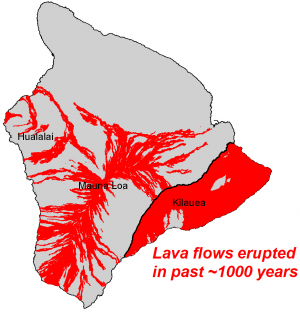Active Hawaiian Volcanoes Summary
[HCV Home]
[Formation of the Islands]
[Active Hawaiian Volcanoes]
[General Info]
 Follow site author @kenrubin on Twitter
Follow site author @kenrubin on Twitter

Active and Potentially Active Hawaiian Volcanoes
|
| Volcano
| Eruption type
| Last eruption
| Status
|
| Loihi |
Lava |
1996 (A.D.) |
active |
| Kilauea |
Lava, ash |
Ongoing since 1983 (A.D.) |
active |
| Mauna Loa |
Lava |
1984 (A.D.) |
active |
| Hualalai |
Lava, ash |
1800 to 01 (A.D.) |
dormant |
| Haleakala |
Lava, ash |
1790 (A.D.) |
dormant |
|
| Mauna Kea |
Lava, ash |
4,000 years ago |
dormant |
| Kohala |
Lava, ash |
120,000 years ago |
exctinct ? |
|
The information in this table is from (1) Wright and Pierson, 1992 (Living with Volcanoes, USGS Circular 1073);
(2) Wolfe, E.W., Wise, S. W., and Dalrymple, B., 1997, The geology and petrology of Mauna Kea Volcano, Hawaii -- A study of postshield volcansim: U.S. Geological Survey Professional Paper 1557, p. 129; and
(3) Garcia, Rubin, Norman, Rhodes, Graham,
Muenow, and Spencer, 1998 (Petrology and geochronology of basalt breccia from the 1996 earthquake swarm of Loihi Seamount, Hawaii: Magmatic history of its 1996 eruption. Bull. Volcanol. vol. 59, p. 577-592).
|
A Graphical View
 Modified USGS map of lava flows (in red) erupted in approximately the past 1,000 years shown on the Island of Hawaii (the names of the three youngest volcanoes on the island have been added for clarity). Notice that Kilauea Volcano is 90% covered with young flows! Map Source and more details.
Modified USGS map of lava flows (in red) erupted in approximately the past 1,000 years shown on the Island of Hawaii (the names of the three youngest volcanoes on the island have been added for clarity). Notice that Kilauea Volcano is 90% covered with young flows! Map Source and more details.
"active", "dormant" and "extinct" volcano terms explained
As you read through the table aobr, you might wonder what it really means when a volcanologist classifies a volcano as "active", "dormant" or "extinct". The terms seem clear enough but the reality is often quite difficult to determine at some volcanoes, particularly those with very infrequent or poorly know eruptive histories. Extinct volcanoes where the last eruption was very long ago, and many times longer than the typical reccurence interval for different types of volcanic systems, can be safely regarded as extinct. These time periods are measured in hundereds of thousands of years. At the other end of the spectrum, it usually takes some humanly recorded or verifiable historical magmatic event to call a currently non-eruptive volcano "active". The terms "dormant" and "extinct" as commonly applied to Quaternary volcanoes are more imprecise because what determines this distinction is not a set period of time since last volcanic event. Instead, it is based on a relationship between the time since last eruption (or other known magmatic event such as intrusion or gas exhalation) and the frequency of eruptions before that last event. If the latter was changing with time (getting more or less frequent), this will affect our judgement of the potential for a fututre eruption. Or, if the eruptive history is poorly known, this will limit our ability to predict the probability of future activity. Ultimately there is often no simple yes or no answer for whether a compound volcano active at least once in the last 10,000-50,000 years is extinct or not. Instead it is a coin toss between calling a volcano dormant or extinct, so we try to provide as much additional information as possible with this assigned status so that other people can evaluate how certain we are of this assessment.
|

VOLCANO UPDATES
Kilauea:
We refer you to the Hawaiian Volcano Observatory (US Geological Survey) website for on-line info about eruptive and seismic activity at Kilauea.
|
|
Loihi seamount<
This page at our site is updated more frequently during times of
heightened activity than during times of relative quiessence.
|

This page created and maintained by
Ken Rubin©,
krubin@soest.hawaii.edu
 Follow site author @kenrubin on Twitter
Follow site author @kenrubin on Twitter
Other credits for this web site.
![]() Follow site author @kenrubin on Twitter
Follow site author @kenrubin on Twitter![]()
![]()
![]()




![]() Follow site author @kenrubin on Twitter
Follow site author @kenrubin on Twitter

 Modified USGS map of lava flows (in red) erupted in approximately the past 1,000 years shown on the Island of Hawaii (the names of the three youngest volcanoes on the island have been added for clarity). Notice that Kilauea Volcano is 90% covered with young flows! Map
Modified USGS map of lava flows (in red) erupted in approximately the past 1,000 years shown on the Island of Hawaii (the names of the three youngest volcanoes on the island have been added for clarity). Notice that Kilauea Volcano is 90% covered with young flows! Map 
